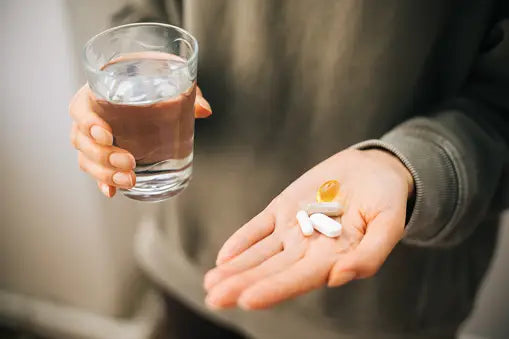

Fish Oils for Muscle Mass
Table of Contents
Fish Oils for Muscle Mass
by: Robbie Durand
Many athletes take protein, creatine, and a pre-workout, but many athletes may be forgetting about a very useful supplement: Fish Oils. Incorporating Omega 3 fatty acids may be another useful supplement to include in an athletes supplement regimen. Evidence supports omega three fatty acids for muscle recovery, body composition, and even brain health.
Fish oils are rich in long-chain n-3 PUFA. Fish oils have been associated with a favorable cardiovascular profile. Fish oil improves endothelial function and reduces inflammation. Fish oils have also been shown to reduce triglycerides as well. Additionally, fish oil consumption profile is associated with favorable changes in body composition. For example, rodent models have also demonstrated a protective effect of fish oil on high-fat-diet-induced obesity, despite no differences in energy intake. Taken together, these findings indicate that lipid utilization is increased from fish oils. Also, some have proposed that n-3-induced insulin sensitivity would enhance glycogen storage, thus shifting the oxidation of carbohydrate onto lipids.
Fish Oils Increase Fat Burning Genes

The incorporation of omega three fatty acids has been associated with increases in fat burning enzymes. Transcription of several genes involved in fat metabolism is also influenced by fish oil ingestion such as carnitine palmitoyltransferase, fatty acid-binding proteins, fatty acid transporter and fatty acyl-CoA sythetase, and malonyl-CoA. Exercise studies show an additive relationship between exercise and fish oil, with the combination of both showing the most preferential changes in body composition.
Body composition is another interesting area. A 2010 study published in the Journal of the International Society of Sports Nutrition found that supplementing with 4 g of fish oil daily for six weeks (1600 mg EPA and 800 mg DHA) improved body composition by significantly increasing lean mass by 1.1–2.2 lb and decreasing fat mass by 1.3%. Another interesting finding was the researchers found a high correlation between lower salivary cortisol levels with omega three fatty acid supplementation.
Fish Oil Increases Fat Oxidation

Some studies have investigated the influence of fish oil on energy metabolism during exercise. One of these has shown a definite increase in fat oxidation during exercise after 4 g/d of fish oil supplementation for three weeks. In this protocol, participants were studied while running at 60% VO2max, under six conditions: (1) in the postabsorptive state; (2) following a high-fat meal; (3) following a high-fat meal supplemented with fish oil; (4 – 6) as in the first three trials, but after chronic supplementation. The energy contribution from fat, estimated by indirect calorimetry, increased by approximately 10 % post-supplementation. Additionally, the researchers found a tendency for enhanced fat oxidation (by approximately 7%) and reduced metabolic glucose disappearance during cycling at 60 % VO2max with fish oil supplementation.
Omega 3 Fatty Acids Increase Muscle Protein Synthesis

In addition to fat burning and cardiovascular function, fish oils may also help out with building muscle. Scientists have suspected that omega three fatty acids may contribute to the overall anabolic signaling response in muscle. They took older adult (> 65 years ) and had them consume either 4 grams of omega three fatty acids or 4 grams of corn oil for eight weeks. The subject’s diets were carefully monitored so they received the same protein; the only difference was the addition of omega 3’s added to the diet. Additionally, the subject’s were told not to engage in heavy resistance exercise.
At the end of eight weeks, the group consuming the omega three fatty acids had omega-3 fatty acid supplementation augments the hyperaminoacidemia- hyperinsulinemia induced increase in the rate of muscle protein synthesis in older adults. Omega-3 fatty acids therefore probably attenuate the anabolic resistance and may potentially be useful as a therapeutic agent to treat sarcopenia. The researchers did find that omega three fatty acids did result in results indicate that it was at least partially mediated via increased activation of the mTOR-p70s6k signaling pathway. The mTORp70s6k-signaling pathway is considered an essential control point for muscle cell growth.
Fish oil supplementation has a plausible rationale for influencing substrate metabolism. A handful of studies has shown trends and significant increases in lipid utilization during exercise with fish oil supplementation. Based on the available literature, increasing fish oil intake modestly (to around 4g/d) may provide some benefits to fat metabolism alongside other health outcomes. Some of the recent studies seem to indicate fish oils may enhance anabolic activity.

A new study published in The Journal of Nutrition reported that omega three fatty acids was associated with lean muscle mass in children. The study looked children ages 7-12 (39% European-American, 34% African-American, and 27% Hispanic-American). Total PUFA intake was positively associated with lean mass and negatively correlated with percentage of body fat and intra-abdominal adipose tissue. A higher ratio of PUFAs to saturated fatty acids was associated with higher lean mass and lower %. Intakes of n-3 and n-6 PUFAs were positively related to lean mass.
The results show that a higher self-reported intake of PUFAs and a higher ratio of PUFAs to saturated fatty acids are positively associated with lean mass and negatively related to visceral adiposity and %BF in a healthy cohort of children aged 7-12 years of age.
These studies suggest that incorporating Omega 3 fatty acids are useful for increasing lean muscle mass and improving body composition.
| Harris WS, Connor WE, Alam N, et al. (1988) Reduction of postprandial triglyceridemia in humans by dietary n-3 fatty acids. J Lipid Res 29, 1451 – 1460. |
Herzberg GR & Rogerson M (1989) The effect of dietary fish oil on muscle and adipose tissue lipoprotein lipase. Lipids 24, 351 – 353.
Jang IS, Hwang DY, Chae KR, et al. (2003) Role of dietary fat type in the development of adiposity from dietary obesity-susceptible Sprague – Dawley rats. Br J Nutr 89, 429 – 438.
Clarke SD (2000) Polyunsaturated fatty acid regulation of gene transcription: a mechanism to improve energy balance and insulin resistance. Br J Nutr 83, Suppl. 1, S59 – S66.
Price PT, Nelson CM & Clarke SD (2000) Omega-3 polyun- saturated fatty acid regulation of gene expression. Curr Opin Lipidol 11, 3 – 7.
Baillie RA, Takada R, Nakamura M, et al. (1999) Coordinate induction of peroxisomal acyl-CoA oxidase and UCP-3 by dietary fish oil: a mechanism for decreased body fat deposition. Prostaglandins Leukot Essent Fatty Acids 60, 351 – 356.
Clarke SD (2001) Polyunsaturated fatty acid regulation of gene transcription: a molecular mechanism to improve the metabolic syndrome. J Nutr 131, 1129 – 1132.
Dangardt F, Osika W, Chen Y, et al. (2010) Omega-3 fatty acid supplementation improves vascular function and reduces inflammation in obese adolescents. Atherosclerosis 212, 580 – 585.
Delarue J, Couet C, Cohen R, et al. (1996) Effects of fish oil on metabolic responses to oral fructose and glucose loads in healthy humans. Am J Physiol Endocrinol Metab 270, E353 – E362.
Couet C, Delarue J, Ritz P, et al. (1997) Effect of dietary fish oil on body fat mass and basal fat oxidation in healthy adults. Int J Obes Relat Metab Disord 21, 637 – 643.
Smith BK, Sun GY, Donahue OM, et al. (2004) Exercise plus n-3 fatty acids: additive effect on postprandial lipemia. Metabolism 53, 1365 – 1371.
Hill AM, Buckley JD, Murphy KJ, et al. (2007) Combining fish-oil supplements with regular aerobic exercise improves body composition and cardiovascular disease risk factors. Am J Clin Nutr 85, 1267 – 1274.
Huffman DM, Michaelson JL & Thomas TR (2004) Chronic supplementation with fish oil increases fat oxidation during exercise in young men. J Exerc Physiol Online 7, 48–56.
Delarue J, Labarthe F & Cohen R (2003) Fish-oil sup- plementation reduces stimulation of plasma glucose fluxes during exercise in untrained males. Br J Nutr 90, 777 – 786.
Boss A, Lecoultre V, Ruffieux C, et al. (2010) Combined effects of endurance training and dietary unsaturated fatty acids on physical performance, fat oxidation and insulin sensitivity. Br J Nutr 103, 1151 – 1159.
Whitehouse AS, Tisdale MJ. Downregulation of ubiquitin-dependent proteolysis by eicosapentaenoic acid in acute starvation. Biochem Biophys Res Commun. 2001 Jul 20;285(3):598-602.
Baar K, Esser K. Phosphorylation of p70(S6k) correlates with increased skeletal muscle mass following resistance exercise. Am J Physiol 1999;276:C120–7.
O’Neil TK, Duffy LR, Frey JW, Hornberger TA. The role of phosphoinositide 3-kinase and phosphatidic acid in the regulation of mammalian target of rapamycin following eccentric contractions. J Physiol 2009;587:3691–701.
Bodine SC, Stitt TN, Gonzalez M, et al. Akt/mTOR pathway is a crucial regulator of skeletal muscle hypertrophy and can prevent muscle atrophy in vivo. Nat Cell Biol 2001;3:1014–9.
Smith GI, Atherton P, Reeds DN, Mohammed BS, Rankin D, Rennie MJ, Mittendorfer B. Dietary omega-3 fatty acid supplementation increases the rate of muscle protein synthesis in older adults: a randomized controlled trial. Am J Clin Nutr. 2010 Dec 15.

















